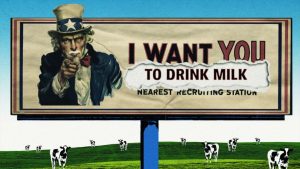
“Let me clear my voice here for a second with a glass of whole milk,” Marshall said, before taking a sip. “The greatest drink known to mankind, known to humankind.”
It wasn’t the first time that the Kansas Republican performatively drank milk in a meeting of the Senate Committee on Agriculture, Nutrition and Forestry. He did the same in a December subcommittee meeting, though that time from a small red carton.
Marshall’s milk consumption in committee coincides with Congress’ efforts to approve the latest version of the farm bill. Every five years, Congress passes sweeping agricultural legislation that deals with everything from commodity prices for major crops like wheat, corn and soybeans; agricultural trade policy; federal crop insurance; and eligibility for the supplemental nutrition assistance program (formerly known as food stamps).
There are a lot of interests at play. What may be great for farmers in Kansas may not be great for those in California. Republicans and Democrats disagree on how much to spend on nutrition programs and whether there should be work requirements for people who rely on food benefits.
Disagreement can even come down to what type of milk students should drink.
In 2010, Congress passed a bill amending the School Lunch Program to set new health guidelines. According to those guidelines, whole milk was no longer eligible for the program, only skim milk. In 2017, the USDA also decided to allow 1% fat milk.
Marshall — and a bipartisan group of lawmakers, mostly from dairy states — want it to cover every type of milk, not just the low fat ones.
“We have a generation of people that did not drink milk in school because they were forced to drink 1% or skim milk, which doesn’t have nearly the flavor of the whole milk that I was raised on,” Marshall told The Star last week. “So I think just in general that they would be choosing hopefully milk as opposed to a carbonated beverage full of sugar.”
Marshall’s love of milk isn’t just nostalgia. The American Farm Bureau, one of the most powerful advocacy groups for farmers in the country, has prioritized adding whole milk back to federal government programs.
Under the dairy section in the organization’s four page priority list, is to have “whole milk being promoted and advanced through the special milk program through schools, nutrition assistance and the U.S. military.”
Advocates for whole milk, who argue the type of fat in milk is a “healthier” fat that is fine in moderation, are working against federal nutritional guidelines that discourage full fat dairy products.
“Most individuals would benefit by increasing intake of dairy in fat-free or low-fat forms, whether from milk (including lactose-free milk), yogurt, and cheese, or from fortified soy beverages or soy yogurt,” the guidelines read.
The guidelines also say that saturated fats, which are commonly found in whole milk, should be less than 10% of the calories someone consumes in a day.
But the U.S. Department of Agriculture also found that 90% of Americans do not meet federal dairy recommendations of up to 3 cups a day (or 1 and a half ounces of natural cheese). Only 34% of teenagers and 20% of adults drink milk in a given day, the USDA found.
“I respect that profession and recognize that there’s a lot of nutrition research,” said Janet Bailey, the CEO of the Kansas Dairy Association. “We see that there is research that says, when you have a nutritious diet, with dairy as a cornerstone of that diet, those are healthy fats. Not all fat is created equal.”
Bailey said there has been rapid growth in Kansas’ dairy industry over the past two decades. The Kansas Department of Agriculture found in 2022 that it is one of the fastest growing dairy states and is ranked 16th in dairy production, the same ranking it had in 2020 and 2018.
While there are dairy farms throughout the state, much of the growth has been in the western part of the state, according to Nancy Brown, the director of policy development at the Kansas Farm Bureau. The total number of Kansas dairies is decreasing, but because the ones in the west are large, the number of cows and milk production has continued to increase. Kansas dairies produced more than 4 billion pounds of milk in 2022, according to the Kansas Livestock Association.
Whether or not schools sell whole milk likely won’t make an immediate impact on dairy farmers, whose products range from dry milk to cheese and yogurt. Instead, advocates for putting whole milk back in school say that it will help people enjoy milk more, potentially turning around what has been a 50-year decline in American milk consumption.
Bailey said research shows that people prefer the taste of whole milk, which she said helps people build a positive relationship with dairy products.
“Good experiences with dairy products really set a young person on a path to consume healthy dairy products throughout their lives,” Bailey said. “And we understand that whole milk tastes better to most people, it just does.”
But one of the most high profile efforts to get kids to drink more milk — the “Got Milk?” advertising campaign that had pictures of celebrities with milk mustaches in school cafeterias across the country — had limited success in getting people to drink more milk.
Still, if Marshall hopes to get whole milk added back to the school lunch program, he has a long way to go. Lawmakers are still debating over which policies will ultimately end up in the farm bill and he says there will likely need to be an extension before the bill’s September 30th deadline.
“We were spending $70 billion a year, and now we’re spending twice that amount of money,” Marshall said. “So how are we going to pay for it? That’s the problem. We’ll keep working at it.”























